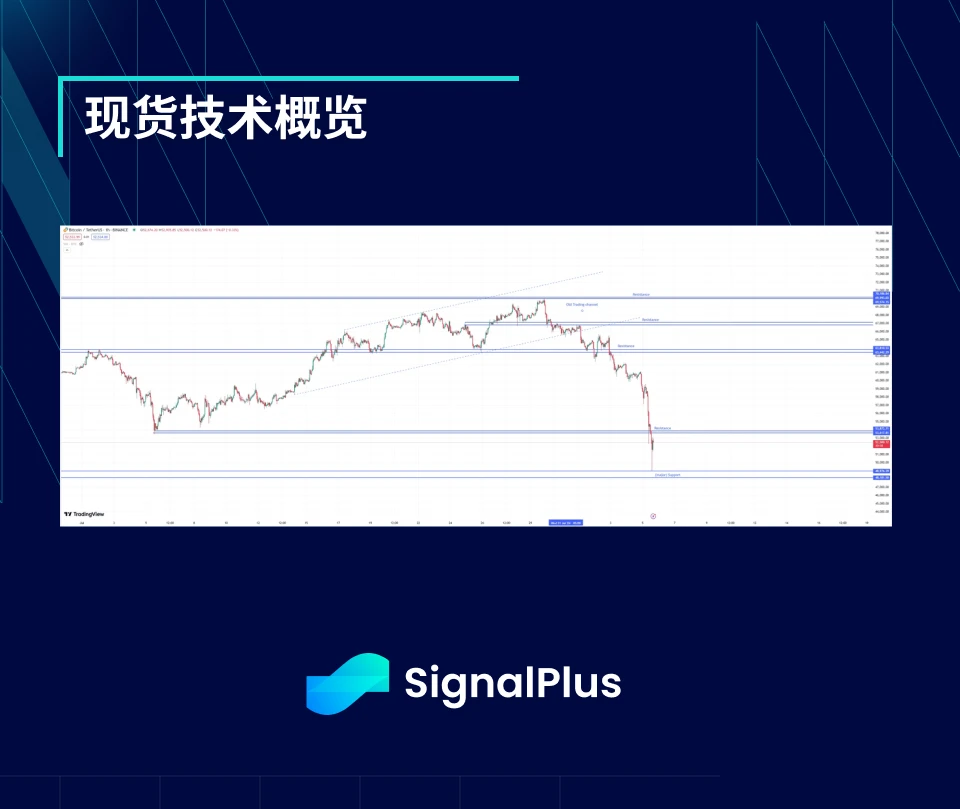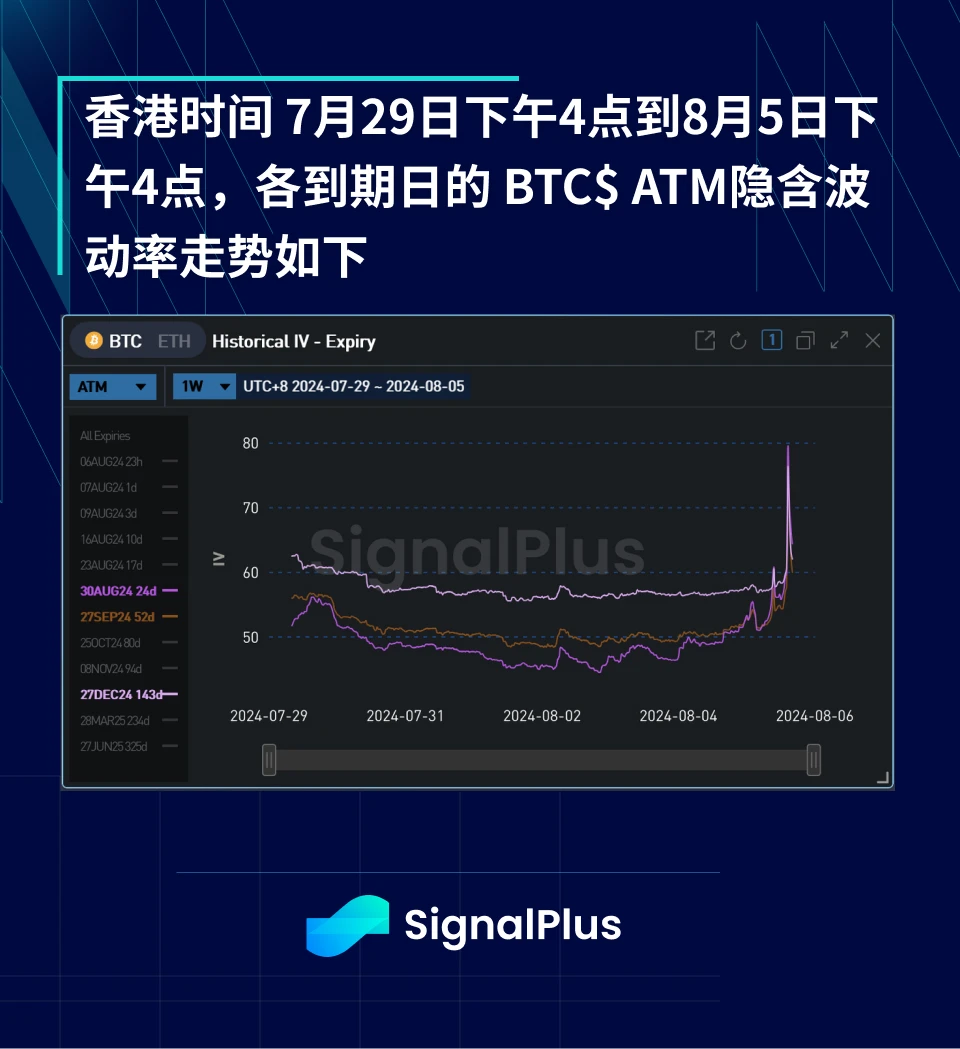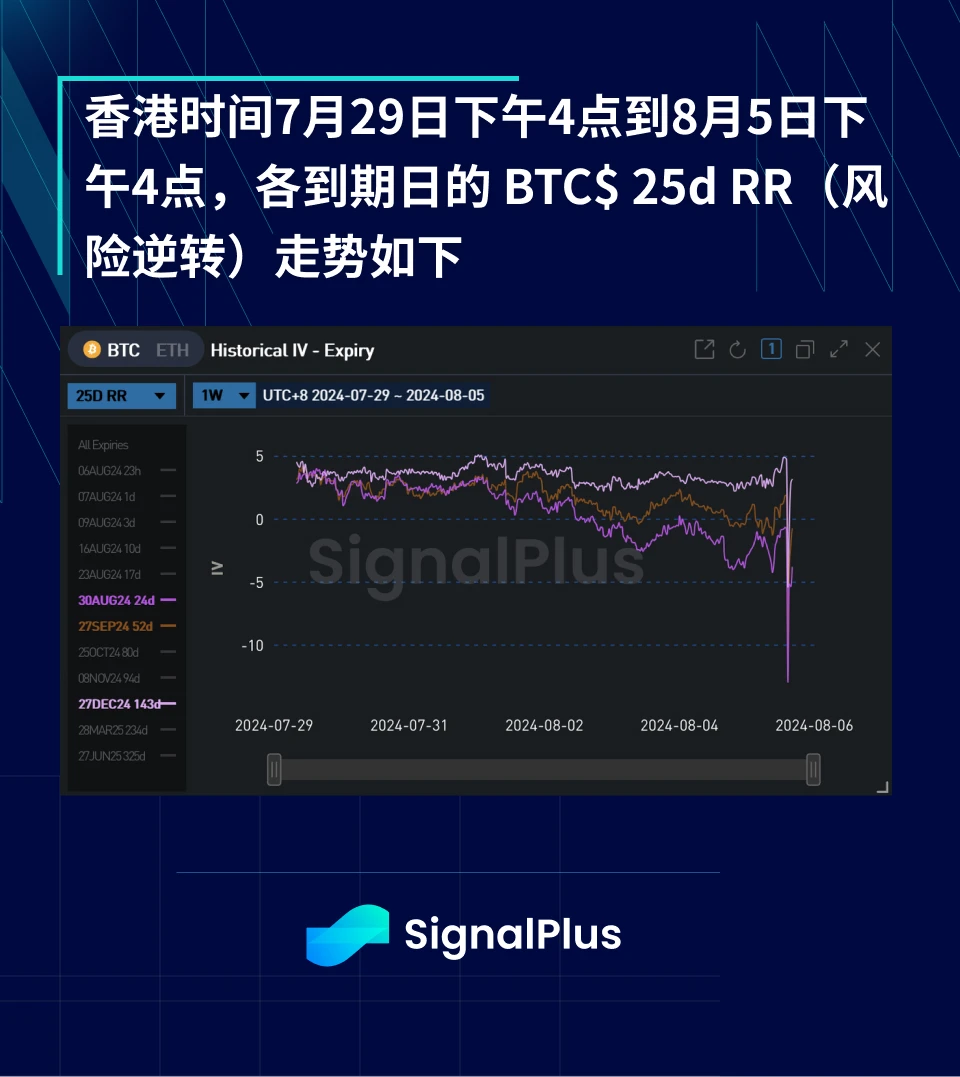BTC-Volatilität: Wochenrückblick 29. Juli–5. August 2024

Key Metrics: (July 29, 4pm -> August 5, 4pm, Hong Kong time):
-
BTC/USD -24.2% ($ 69, 500 -> $ 52, 700) , ETH/USD -30.0% ($ 3, 370 -> $ 2, 360)
-
BTC/USD December (end of year) ATM volatility + 1.5% (61.1 -> 62.0), December 25 d RR volatility unchanged (3.3 -> 3.3)

-
The previous trading channel and key support level were breached sharply, marking the end of the previous phase of testing local highs
-
The main support level is below 50k. BTC briefly dropped to 49k earlier today and then basically held
-
Short-term resistance is at 54k – if this level is breached, the market could consolidate in the 54 – 64k range, trying to regain its footing in the last quarter of the year
Marktereignisse:
-
As growth data deteriorates, fears of a US recession continue to grow; despite this, the Fed did not seem to be in a hurry to start a rate cut cycle at its July meeting, leaving room for a September rate cut but not confirming the markets positive expectations for an upcoming rate cut.
-
Escalating geopolitical rhetoric and growing concerns about a recession have significantly increased risk aversion in traditional financial markets
-
For example, the Nikkei index erased 27% of its year-long gains in a few trading days, and the indexs implied volatility changed by a record amount in 48 hours (even higher than the global financial crisis and the COVID-19 pandemic in March 2020).
-
The crypto market initially did not know how to react to this situation, as weak US data led to rising expectations of a sharp rate cut, which pushed down the dollar against G10 currencies and precious metals; however, heavy risk aversion prevented beta currencies/cryptocurrencies from rebounding and led to forced liquidations, ultimately sending ETH and BTC to cycle lows against the dollar.
-
Initially, crypto implied volatility levels also lagged the rise in cross-market volatility, partly due to the continued increase in supply last week and partly due to the chaotic price action in the early stages. However, as the market cleared today, crypto implied volatility rose sharply as expected.
Implizite Volatilität am Geldautomaten:

-
In the first 5 days of this week, implied volatility levels moved lower across the curve, with spot prices steadily falling from 70k to the 63-65k range, while a continued supply of year-end options and the unwinding of call options for the 2024 BTC summit were observed.
-
Despite the extreme risk aversion in traditional financial markets on Friday and a sharp surge in VIX, BTCUSD volatility initially remained muted, with spot prices remaining above 60k. However, as spot prices attempted to fall below 60k over the weekend, volatility began to rise.
-
As Asian markets crashed early Monday, forced liquidations of BTC and ETH caused spot prices to fall a further 10% and triggered a brief burst in implied volatility, with the BTCUSD August expiration contract surging from 56 in the morning (a low of 45 this week) to 80 before falling back to just above 60. There was also a brief spike in volatility on the forward curve, with the December year-end contract briefly rising from 58 to 72 before falling back to 62 — with little net change this week.
-
Barring another geopolitical escalation or another significant sell-off in equities, we would expect front-end implied volatility levels to retreat 5-10 basis points, with forward volatility finding some support as markets once again prove it is nearly impossible to hold a structurally bullish view in the cash market.
Schiefe/Konvexität:

-
The skew for the front-end expiring contracts was flat this week, and the August skew followed the spot price lower – starting from just under 4 volatility upside at the beginning of the week and ending at 4 volatility downside at the weekend, reflecting the shift in spot market sentiment and the significant actual volatility change on the downside
-
Observe that the correlation between spot prices and implied volatility is negative in the forward expirations, and implied volatility has been climbing upwards this weekend as spot prices have fallen sharply…Nevertheless, the skew on the forward curve remains firmly upwards
-
With the Fed expected to shift to an aggressive rate-cutting cycle, coupled with bullish sentiment surrounding the Trump affair, upside tail demand for Vega remains strong, while year-end upside supply is likely to be reduced at these lower spot levels.

-
Todays volatility explosion caused a sharp increase in realized volatility, leading to a rise in convexity this weekend
-
Forced liquidations across the market may also have driven the unwinding of covering short positions, exerting upward pressure on convexity.
-
Overall, given the paradigm shift in the market, if we can cleanly break out of the 50 – 70k price range, demand for option strikes beyond that range will remain strong; furthermore, at current levels, the correlation of actual spot prices to risk reversals can be seen on both sides of the spot distribution.
Good luck!

You can use the SignalPlus trading vane function at t.signalplus.com to get more real-time crypto information. If you want to receive our updates immediately, please follow our Twitter account @SignalPlusCN, or join our WeChat group (add assistant WeChat: SignalPlus 123), Telegram group and Discord community to communicate and interact with more friends. SignalPlus Official Website: https://www.signalplus.com
This article is sourced from the internet: BTC Volatility: Week in Review July 29–August 5, 2024
Originalautor: Huo Huo In letzter Zeit gab es viele regulatorische und negative Nachrichten. Am 28. Juni reichte die US-Börsenaufsichtsbehörde (SEC) eine Klage gegen Consensys ein und warf dem Unternehmen vor, sich nicht als Broker über den Swap-Dienst MetaMask registriert zu haben. Dies geschah nur zwei Wochen, nachdem die SEC Consensys mitgeteilt hatte, dass sie ihre Untersuchung zu Ethereum 2.0 beendet habe. Relevanten Informationen zufolge begann das erste harte Vorgehen der SEC gegen Kryptowährungen im Jahr 2017, als sie eine Cyber-Einheit einrichtete, die sich mit einer dezentralisierten autonomen Organisation namens The DAO befasste. Später wurde die Einheit in Crypto Assets and Cyber Unit umbenannt, und die SEC verstärkte ihre Aufsicht über den Kryptowährungsmarkt und leitete eine Reihe von Durchsetzungsmaßnahmen gegen die Emission nicht registrierter Wertpapiere, Betrug und Marktmanipulation ein. Im Jahr 2023…







